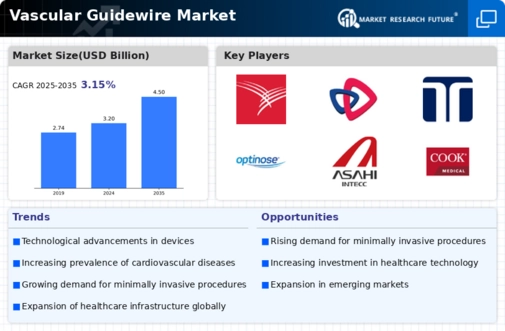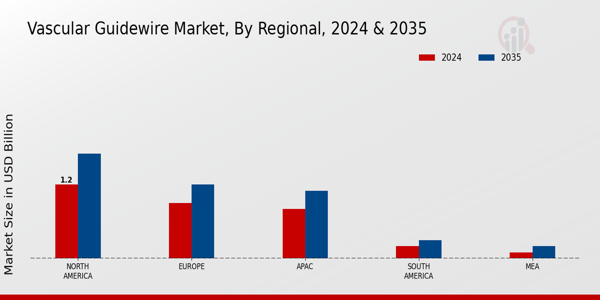Expansion of Healthcare Infrastructure
The expansion of healthcare infrastructure, particularly in emerging economies, is a key driver of the Global Vascular Guidewire Market Industry. As countries invest in modernizing their healthcare systems, the availability of advanced medical devices, including vascular guidewires, is increasing. This growth is particularly evident in regions where access to healthcare services has historically been limited. Enhanced infrastructure not only improves the distribution of medical devices but also fosters the adoption of innovative technologies. As a result, the market is likely to witness substantial growth, aligning with the broader trends of healthcare development and modernization.
Increasing Prevalence of Vascular Diseases
The Global Vascular Guidewire Market Industry is experiencing growth due to the rising incidence of vascular diseases, including peripheral artery disease and coronary artery disease. According to health statistics, these conditions are becoming more prevalent, particularly among aging populations. This trend necessitates advanced medical interventions, thereby driving demand for vascular guidewires. As healthcare providers seek to improve patient outcomes, the adoption of innovative guidewire technologies is likely to increase. This growing need for effective treatment options is expected to contribute significantly to the market, which is projected to reach 3.2 USD Billion in 2024.
Technological Advancements in Guidewire Design
Technological innovations play a crucial role in shaping the Global Vascular Guidewire Market Industry. Recent advancements in materials and design have led to the development of guidewires that offer enhanced flexibility, torque control, and biocompatibility. These improvements facilitate more precise navigation through vascular pathways, thereby improving procedural success rates. For instance, the introduction of hydrophilic coatings has been shown to reduce friction, allowing for smoother insertion and manipulation. As healthcare providers increasingly adopt these advanced guidewires, the market is expected to expand, with projections indicating a growth to 4.5 USD Billion by 2035.
Rising Demand for Minimally Invasive Procedures
The shift towards minimally invasive surgical techniques is significantly influencing the Global Vascular Guidewire Market Industry. These procedures are associated with reduced recovery times, lower risk of complications, and improved patient satisfaction. As a result, there is a growing preference for guidewires that facilitate such interventions. The increasing number of procedures, including angioplasty and stenting, is driving the demand for specialized guidewires. This trend is likely to continue, as healthcare systems worldwide prioritize patient-centric approaches. Consequently, the market is projected to grow at a CAGR of 3.15% from 2025 to 2035, reflecting the ongoing transition towards less invasive treatment options.
Regulatory Support for Medical Device Innovation
Regulatory bodies are increasingly supporting innovation within the Global Vascular Guidewire Market Industry. Streamlined approval processes and initiatives aimed at fostering medical device development are encouraging manufacturers to introduce novel guidewire technologies. This regulatory environment is conducive to the rapid introduction of products that meet evolving clinical needs. For instance, the expedited approval pathways for breakthrough devices are likely to accelerate the availability of advanced guidewires. As manufacturers respond to these opportunities, the market is expected to benefit from a steady influx of innovative products, further driving growth.



















